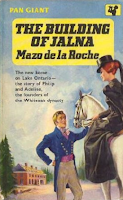 The Watching Cat
The Watching Cat
Pamela Fry
London: Davies, 1960
Who was Pamela Fry? None of my Montreal friends, bookish types all, have been able to answer this question. Yet the married "Miss Fry" once lived in the city and twice used it as a setting in mystery novels. Both were published by respected houses, both were lauded in the pages of the New York Times and both have been out of print for half a century.
The Watching Cat, Pamela Fry's second mystery, stumbles out of the gate with an entirely unimaginative premise: Catherine Ellis, a young, single schoolteacher from a remote Manitoba town inherits a large Montreal house from a previously unknown, eccentric uncle. Much as I'd hoped the work would quickly ready itself, Miss Fry fairly clings to cliché as the story falters forward. Poor Catherine, an orphan, enters what she expects to be an empty domicile only to encounter an evil stepmother, an unstable half-sister and a tall, dark and handsome lodger. A shady lawyer works in the background as those in the know sneak about the house looking for riches hidden away by the recently deceased funny uncle.

It all seems so forgettable, but I'll remember The Watching Cat as one of the most disappointing novels I've ever read. The author has a peculiar penchant for planting, then ignoring, seeds of a dark psychological drama. When the evil stepmother relates stories of family mental illness, Catherine begins to question her own sanity – but only for a paragraph or two. Gaslight invariably dims to a Nancy Drew mystery, as when our heroine is awoken by a scratching sound:
The noise came from somewhere very close – surely it was the other side of this very wall, the wall alongside her bed. There was someone in Uncle Jeremiah's room... She looked at the luminous dial of her watch. It was three minutes to four... But who could be in there at this time of night – and for what reason?
So boring, so bland... and yet on occasion The Watching Cat stretches to rise above it all. Catherine's half-sister, for example, proves not to be mentally ill, rather she's a heroin addict. Her pusher is boyfriend Eddie, a young medical school drop-out who is not only in on the scheme, but is probably sleeping with the evil stepmother. And there's a good deal of fun, like when small town girl Catherine, dressed in a hideous handmade green taffeta gown, attends a party populated by beats.

 Nearly everything I know about the attractive Miss Fry is found in the book's author biography. Her debut novel, Harsh Evidence, published in London by Wingate (1953) and in New York by Roy Publishers (1956), is held by all of nine libraries worldwide. Harsh Evidence isn't listed for sale online, and seems exceedingly scarce – only the British Library has the Wingate edition – so you'll understand my surprise in discovering that it was translated into both Swedish (De döda tala ej, 1956) and Finnish (Kuolleet eivät puhu!, 1957) .
Nearly everything I know about the attractive Miss Fry is found in the book's author biography. Her debut novel, Harsh Evidence, published in London by Wingate (1953) and in New York by Roy Publishers (1956), is held by all of nine libraries worldwide. Harsh Evidence isn't listed for sale online, and seems exceedingly scarce – only the British Library has the Wingate edition – so you'll understand my surprise in discovering that it was translated into both Swedish (De döda tala ej, 1956) and Finnish (Kuolleet eivät puhu!, 1957) .

Did more mysteries follow? The only other books I've been able to uncover by Miss Fry are
The Good Cook's Encyclopedia and
The Good Housewife's Encyclopedia, both published in the early 'sixties by London's Spring Books. I'll step out on a limb and speculate that a third Spring title,
Cooking the American Way, is naught but a repackaging of the first.
Who was Pamela Fry? Disappointed as I was by The Watching Cat, it contained just enough quirk to keep me in the hunt for the answer.

Object: A very attractive hardcover in dark blue boards. I can't quite make out the cover artist's signature. My copy, signed with publisher card, was purchased this past autumn from a Montreal bookseller who tells me that he has never seen another. It would appear that that this, the novel's only edition, received no second printing. No Swedish or Finnish translations this time.

Access: A rare book, Canadian library patrons will find The Watching Cat at the University of Toronto, the University of British Columbia and the University of Victoria. A mere three copies are listed for sale online. At US$15.77, Serendipity Books of West Leederville, Australia offers the one in best condition ("top edge foxed else v.g. in worn and sl. torn d/w"). Second place, goes to a New Zealand bookseller who is selling a slightly less attractive copy for an even twenty American dollars. A Canadian bookseller in Oakville, Ontario brings up the rear by asking C$60 for a crummy thing that lacks the dust jacket and front flyleaf. On the other hand, The Watching Cat is so uncommon that it might just be worth the price.













































